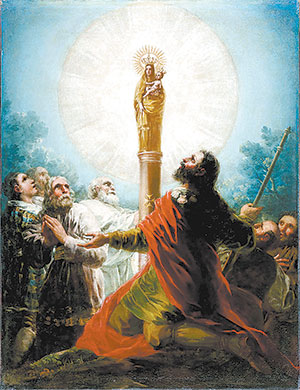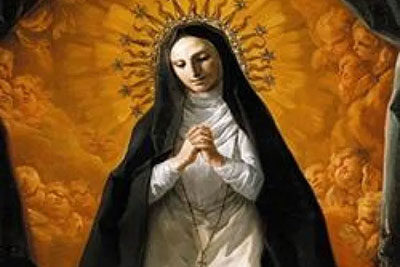Our Lady of the Pillar is patroness of Spain and all Hispanics
 Our Lady of the Pillar (officially in Spanish, “Nuestra Señora del Pilar de Zaragoza”) is recognized as the first Marian apparition in the history of Christianity and is the only one that happened while the Virgin Mary was still alive. Although it was technically a bilocation of Our Lady, because she was living with John the Apostle in Jerusalem, it is still regarded as an apparition by the tradition of the Church.
Our Lady of the Pillar (officially in Spanish, “Nuestra Señora del Pilar de Zaragoza”) is recognized as the first Marian apparition in the history of Christianity and is the only one that happened while the Virgin Mary was still alive. Although it was technically a bilocation of Our Lady, because she was living with John the Apostle in Jerusalem, it is still regarded as an apparition by the tradition of the Church.
According to tradition, James the Greater, brother of St. John the Evangelist, traveled with great effort to Roman Hispania (modern-day Spain) to evangelize the local tribes. He not only confronted great difficulties, but he also saw very little apostolic fruits of conversion. Tradition says that when he was at his lowest point of discouragement, in 40 A.D., while he was sitting by the banks of the Ebro River in Zaragoza (back then known as Caesaraugusta), Mary appeared to him accompanied by thousands of angels to console and encourage him.
The Virgin Mary, with the Child Jesus in her arms and standing on a pillar, asked St. James and his eight disciples to build a church on the site, promising that “it will stand from that moment until the end of time in order that God may work miracles and wonders through my intercession for all those who place themselves under my patronage.”
The church of Our Lady of the Pillar in Zaragoza is the first church dedicated to Mary in history, and it remains standing to this day, having survived invasions and wars.
During the Spanish Civil War (1936-1939), the Communists dropped three bombs on the church from an airplane. The bombs tore through the roof and hit the floor, but none of them exploded. The three now deactivated bombs are currently on display in one of the basilica’s walls.
Our Lady is also said to have given the small wooden statue of the apparition to St. James. It now stands on the pillar she arrived on. The wooden statue is a relatively simple image 15 inches high, standing on a jasper pillar 5.9 feet tall. But the crown adorning her head is a masterpiece. It was made in 44 days by 33 workmen. The sun-like crown is made of 2,836 diamonds cut triangularly, 2,725 roses, 145 pearls, 74 emeralds, 62 rubies and 46 sapphires. The crown of the baby Jesus is identical in shape, although not in size.
The basilica has been redesigned and expanded several times during its history. The current structure, completed in the 17th century, includes 11 brightly colored tiled domes and is the second biggest church in Spain.
Nuestra Señora del Pilar is not only the patroness of Spain but also of all Hispanic peoples, since it was on Oct. 12, 1492, the feast of Our Lady of the Pillar, that Christopher Columbus arrived on American land and the first Mass in the Americas was celebrated.
— Alejandro Bermudez, Catholic News Agency
 On Oct. 16, Roman Catholics celebrate the life of St. Margaret Mary Alacoque, the French nun whose visions of Christ helped to spread devotion to the Sacred Heart throughout the Western Church.
On Oct. 16, Roman Catholics celebrate the life of St. Margaret Mary Alacoque, the French nun whose visions of Christ helped to spread devotion to the Sacred Heart throughout the Western Church.
Margaret Mary Alacoque was born in July of 1647. Her parents Claude and Philiberte lived modest but virtuous lives, while Margaret showed herself to be a serious child with a focus on God. Claude died when Margaret was 8, and she suffered a paralyzing illness from the ages of 9 to 13. A struggle over her family's property made life difficult for Margaret and her mother for several years.
During her illness, Margaret made a vow to enter religious life. During adolescence, however, she changed her mind. For a period of time she lived a relatively ordinary life, enjoying the ordinary social functions of her day and considering the possibility of marriage.
Her life changed in response to a vision she saw one night while returning from a dance, in which she saw Christ being scourged. Margaret believed she had betrayed Jesus, by pursuing the pleasures of the world rather than her religious vocation. At age 22, she decided to enter a convent.
Two days after Christmas of 1673, Margaret experienced Christ's presence in an extraordinary way while in prayer. She heard Christ explain that he desired to show his love for the human race in a special way, by encouraging devotion to "the heart that so loved mankind."
She experienced a subsequent series of private revelations regarding the gratitude due to Jesus on the part of humanity, and the means of responding through public and private devotion. But the superior of the convent she dismissed this as a delusion.
This dismissal was a crushing disappointment, affecting the nun's health so seriously that she nearly died. In 1674, however, the Jesuit priest Father Claude de la Colombiere became Margaret's spiritual director. He believed her testimony, and chronicled it in writing.
Father de la Colombiere – later canonized as a saint – left the monastery to serve as a missionary in England. By the time he returned and died in 1681, Margaret had made peace with the apparent rejection of her experiences. Through St. Claude's direction, she had reached a point of inner peace, no longer concerned with the hostility of others in her community.
In time, however, many who doubted her would become convinced as they pondered what St. Claude had written about the Sacred Heart. Eventually, her own writings and the accounts of her would face a rigorous examination by Church officials.
By the time that occurred, however, St. Margaret Mary Alacoque had already gained what she desired: "To lose myself in the heart of Jesus." She faced her last illness with courage, frequently praying the words of Psalm 73: "What have I in heaven, and what do I desire on earth, but Thee alone, O my God?"
She died on Oct. 17, 1690, and was canonized by Pope Benedict XV in 1920.
— Catholic News Agency

